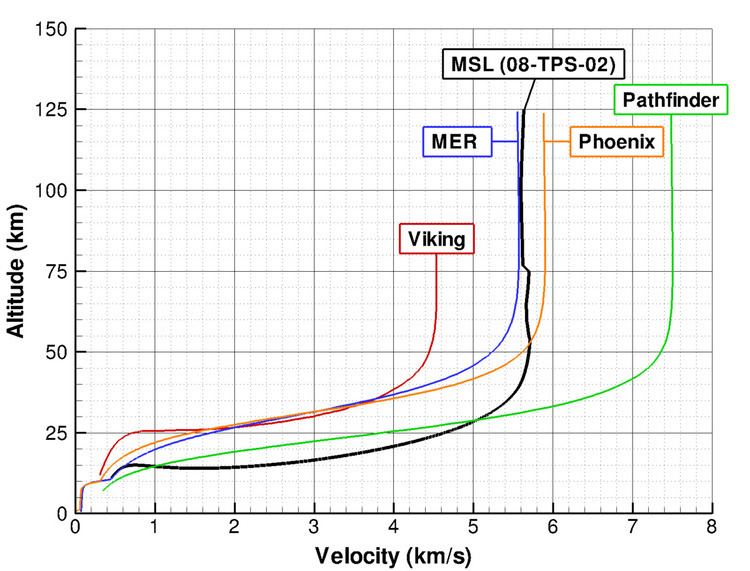 | ||
Mars atmospheric entry is the entry into the atmosphere of Mars. High velocity entry into Martian air creates a CO2-N2 plasma, as opposed to O2-N2 for Earth air. Mars entry is affected by the radiative effects of hot CO2 gas and Martian dust suspended in the air. Flight regimes for entry, descent, and landing systems include aerocapture, hypersonic, supersonic, and subsonic.
Contents
Thermal protection systems and atmospheric friction have been used historically to reduce most of the kinetic energy that needs to be lost prior to landing, with parachutes and, sometimes, a final bit of retropropulsion used in the final landing. High-altitude high-velocity retropropulsion is being researched for future transport flights landing heavier cargos.
For example, Mars Pathfinder entered in 1997. About 30 minutes prior to entry, the cruise stage and entry capsule separated. When the capsule hit the atmosphere it de-accelerated from about 7.3 km/s to 0.4 km/s (16330 mph to 900 mph) over three minutes. As it descended the parachute opened to slow it down further, and soon after the heat shield was released. During entry a signal was relayed back to Earth, including semaphore signals for important events.
Examples
Some examples of spacecraft that have attempted to land on the surface of Mars:
Technologies
A deployable decelerator like a parachute can slow down a spacecraft after a heat shield. Typically a Disk-Gap-Band parachute has been used, but another possibility are trailing or attached inflatable entry devices. Inflatable types include sphere w/ fence, teardrop w/ fence, isotensoid, torus, or tension cone and attached types include isotensoid, tension cone, and stacked toroid blunted cone. Viking Program era researchers were the true pioneers of this technology, and development had to be restarted after decades of neglect. Those latest studies have shown that tension cone, isotensoid, and stacked torus may be the best types to pursue.
Finland's MetNet probe may use an expandable entry shield if it is sent. Martian air can also be used for aerobraking to orbital velocity (aerocapture), rather than descent and landing. Supersonic retro-propulsion is another concept to shed velocity.
NASA is carrying out research on retropropulsive deceleration technologies to develop new approaches to Mars atmospheric entry. A key problem with propulsive techniques is handling the fluid flow problems and attitude control of the descent vehicle during the supersonic retropropulsion phase of the entry and deceleration. More specifically, NASA is carrying out thermal imaging infrared sensor data-gathering studies of the SpaceX booster controlled-descent tests that are currently, as of 2014, underway. The research team is particularly interested in the 70–40-kilometer (43–25 mi) altitude range of the SpaceX "reentry burn" on the Falcon 9 Earth-entry tests as this is the "powered flight through the Mars-relevant retropulsion regime" that models Mars entry and descent conditions.
Example (Mars Science Laboratory)
The following data were compiled by Mars Science Laboratory's Entry, Descent and Landing team at NASA's Jet Propulsion Laboratory. It provides a timeline of critical mission events that occurred on the evening of August 5 PDT (early on August 6 EDT).
Curiosity's EDL team releases a timeline for mission milestones (depicted in this artist's concept) surrounding the landing of the Mars rover.
